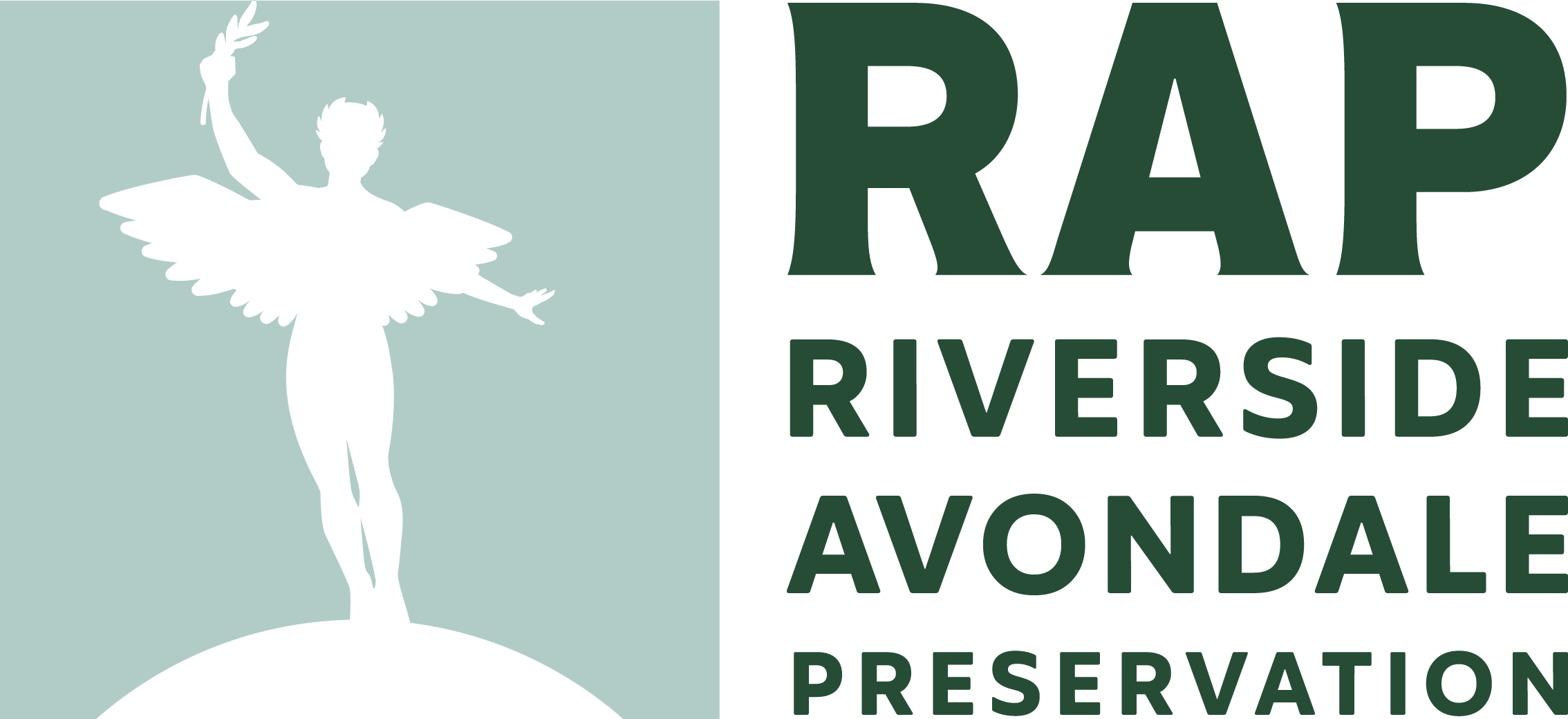Riverside and Avondale next-door, established fifty years apart and both with different vibes, gradually coalesced into one great neighborhood. Riverside is the older, artsy cousin with its famous Memorial Park, Cummer Museum, Arts District, uniquely local dining, hip 5 Points commercial district and Riverside Arts Market. Avondale, the younger cousin, is smaller and more residential in nature but offers a more establishment-style commercial district and several destination restaurants. Combined they offer history, architectural gems, eclectic business districts, arts & culture, and public spaces people travel to feel and see.
 Architectural Gems
Architectural Gems
From grand examples of Colonial Revival mansions to ubiquitous yet functional bungalows and exotic residences that defy singular classification, Riverside Avondale's eclectic mix of architectural styles is unparalleled among neighborhoods in the Southeast. In an effort to preserve Jacksonville's historic resources in 1974 the Jacksonville Historical and Cultural Conservation Commission began an inventory of historic sites that was completed by the Jacksonville Historic Landmarks Commission a few years later in a comprehensive report. Unfortunately, many of these sites are gone including a majestic row of mansions on Riverside Avenue from Margaret Street to Forrest Street.
The Commission developed a priority list of historical landmarks for preservation. In Riverside and Avondale 15 sites were awarded the highest priority of four stars because they had, "Great significance to the city and warrants the maximum preservation efforts." Riverside Avondale Preservation founder, Dr. Wayne Wood, compiled the Commission's work into a seminal book, Jacksonville's Architectural Heritage - Landmarks For The Future. We thank him for the use of his words and photographs on this website. See all fifteen Riverside Avondale four-star sites here and more!
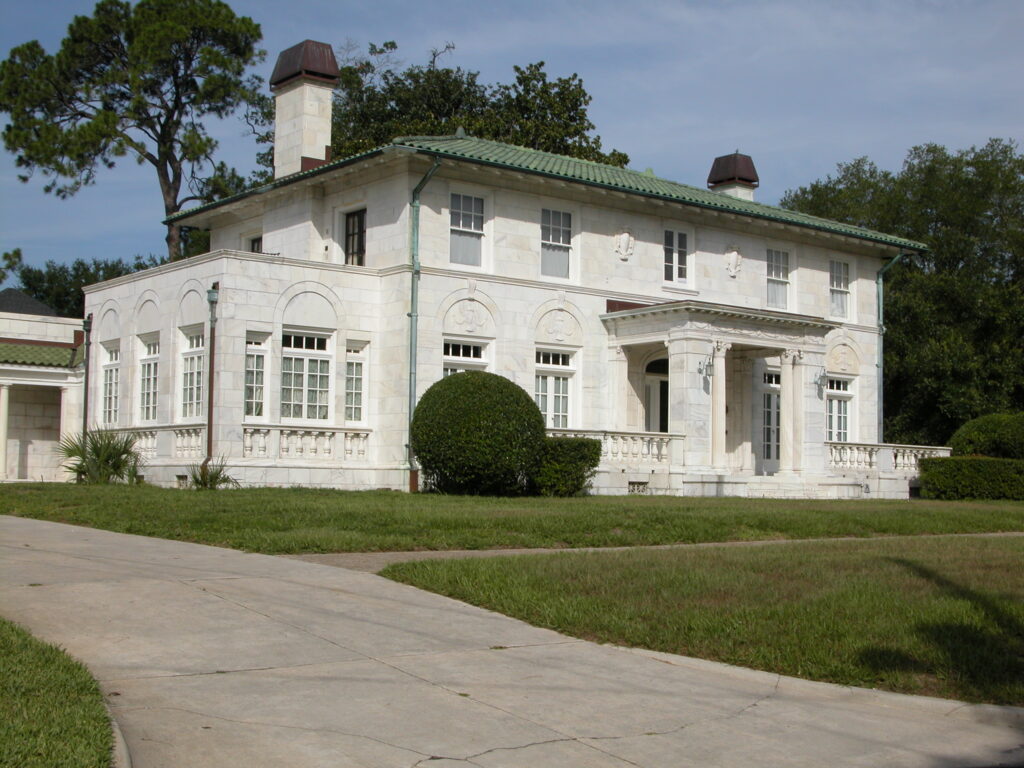
Bryson Residence
1704 Avondale Avenue
Date: 1927-28
Architects: Mark & Sheftall
Builder: Walter J. Bryson
Due to its prominent location, the "Marble House" has been one of the most well-known symbols of Avondale's elegance since the time of its completion. It is an interesting variation of the Mediterranean Revival style, with classical elements such as the ornate entrance porch and a balustrade across the terrace. The most unusual feature of the house is its exterior veneer, which is marble quarried in Georgia. Most of the ornamentation on the main facade is also marble, including the cartouches that flank the upstairs balcony, the arched bas-relief panels over the French doors, and the frieze on the entry porch. The residence was originally built at a cost of over $70,000 for contractor Walter Bryson, who had to sell the house shortly after completion due to the "crash" at the end of the Florida Land Boom. However, his son was able to buy the house back fifteen years later and lived there for many years.

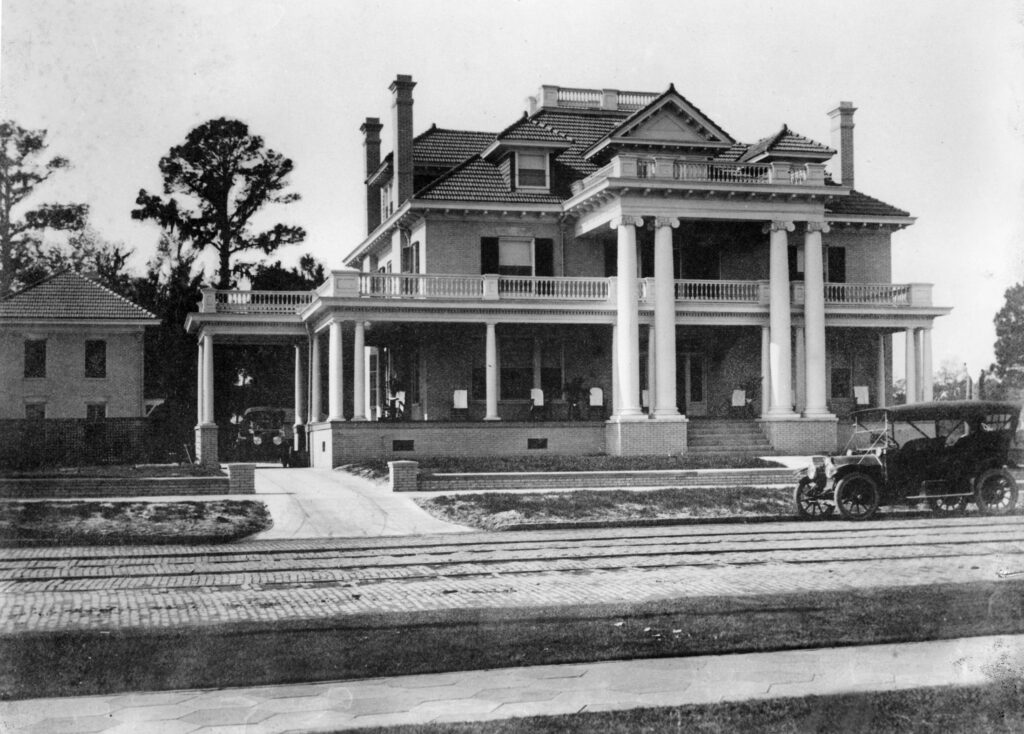
Martha Washington Hotel
1636 King Street
Date: 1911 (original); 1938 (addition)
Achitect: Unknown (original); Kenyon Drake (addition)
Builder: Unknown (original); Ivy H. Smith Company (addition)
At the time of its construction in 1911, this three-story Colonial Revival house was one of the largest mansions in "Riverside Annex," as the area around King Street was then known. It was built for lumberman Bryan W. Blount. In 1938 the building became a hotel with a large addition added to the back. The name "Martha Washington" was chosen to capitalize on the fame of the George Washington Hotel downtown and to designate that this was a hotel for women. The female-only concept was short-lived, however, and during World War II it housed various boarders, including servicemen's families. The Martha Washington continued as a residential hotel until 1977, when it closed and was slated for demolition. Just as the wrecking company had begun dismantling the building, a group of investors organized by Riverside Avondale Preservation came forward to save it. The group then resold the building to a developer who converted it to condominiums. Although the original residence has been altered by the 1938 addition and by the enclosure of part of the veranda, it is still one of Riverside's most prominent architectural landmarks. Its noteworthy features include monumental Doric columns and numerous dormers.

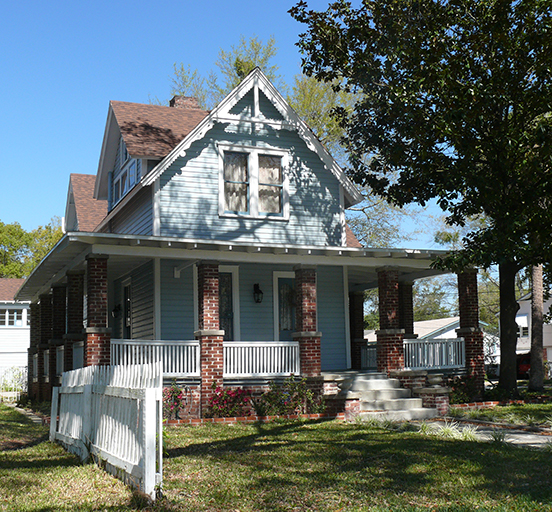
Jaudon Residence
2793 Lydia Street
Date: ca. 1857
This house on Lydia is typical of vernacular farmhouses found on North Florida's plantations at the time of the Civil War, where life was generally rustic and with few amenities. This house is L-shaped with decorative vergeboards, collar beams, and pendants in the two gables. The porch and the dormers were added after the turn of the century, as was the rear wing. The approximate date of the house is confirmed by the presence of beams and joists cut with a circular saw, which was not used in this area prior to the mid-1850's. The roof was originally covered with wooden shingles, or shakes, which were also circular saw cut. The structure of the house shows an early example of balloon framing, and old-fashioned cut nails were used in its construction. This structural evidence dates the house between 1855 and 1870, making it the oldest known building remaining in Riverside.

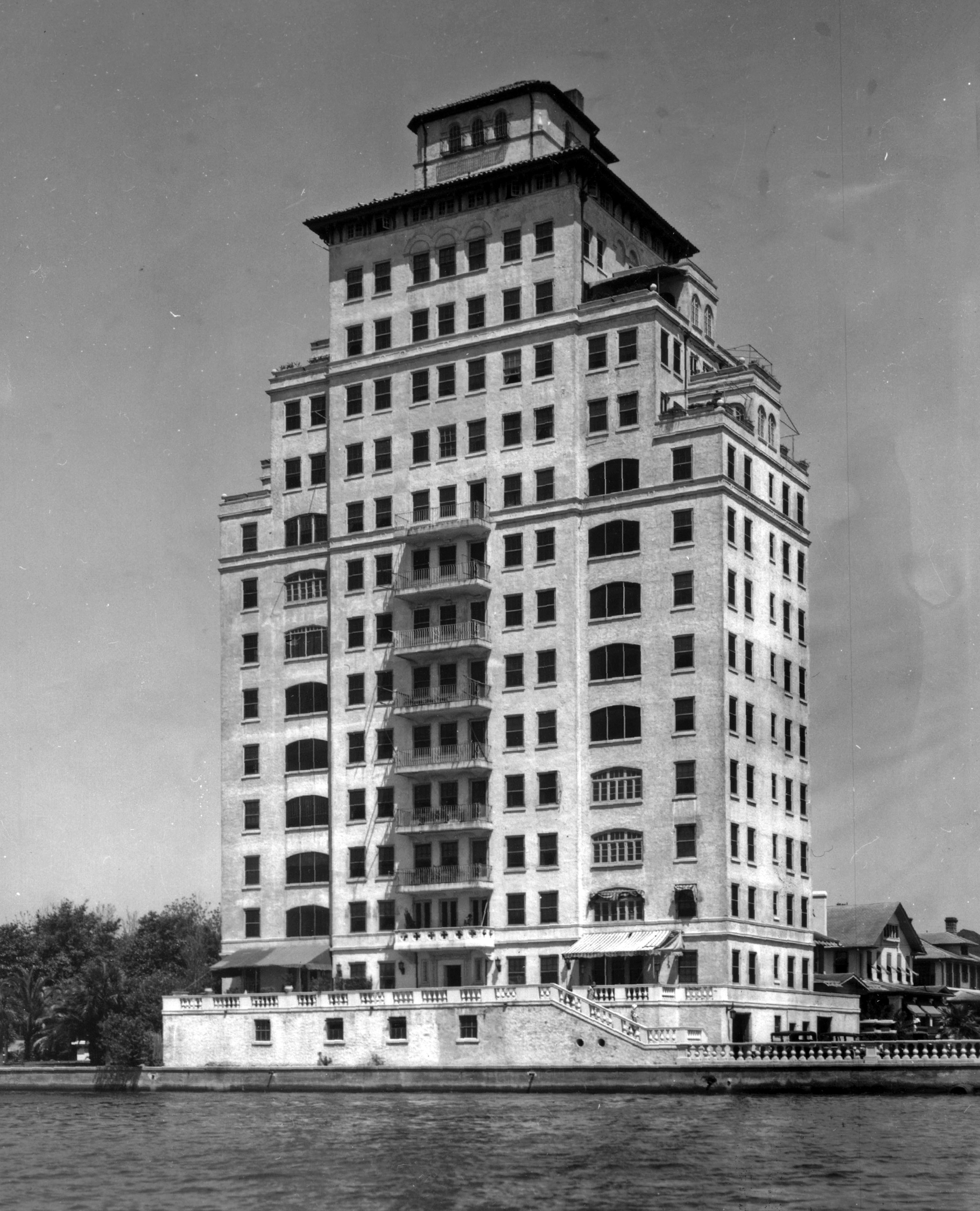
Park Lane Apartments
1846 Margaret Street
Date: 1926
Architect: Roy A. Benjamin
Builder: Realty Construction Company - Atlanta
The sixteen-story Park Lane was Riverside's first high-rise building and caused quite a stir when it was built in 1926. It towered over Memorial Park and was completely out of scale with the stately residences around it. For many years the Park Lane was Jacksonville's third-tallest building. It was originally built as co-op apartments, a novel idea in those days, which the developer Francis Mason brought back from a trip to New York. The Park Lane was the forerunner of Florida's high-rise condominiums. It was also the first tall building in Jacksonville to use "setback" construction, permitting the apartments in the upper stories to have open terraces and sun parlors. The Mediterranean Revival-influenced building was constructed on a narrow tract of land, which was formerly the front yard of a two-story riverfront residence. Consequently, the building is very thin, and many apartments have windows facing on both the north and south sides of the building. The Park Lane cost about $800,000 to build, and the original units sold for $12,000 and up.

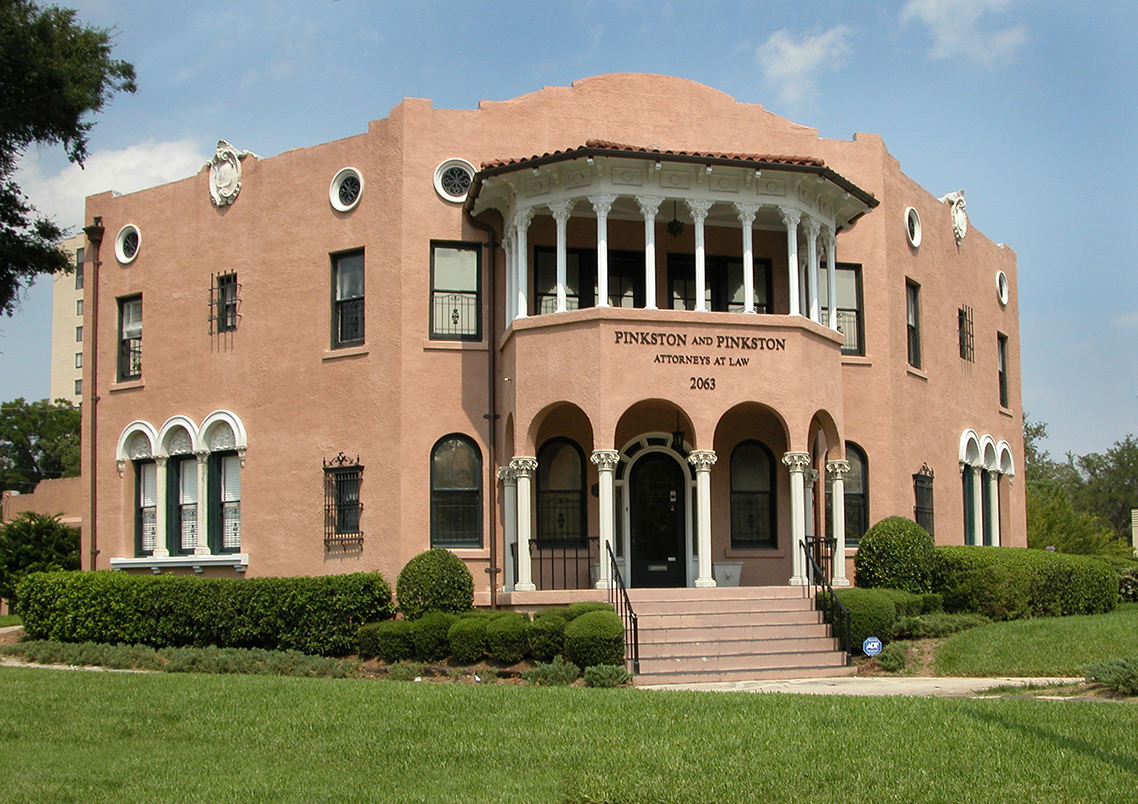
Drs. Love & McGinnis Residence
2063 Oak Street
Date: 1926
Architect: Henry. J. Klutho
Builder: Charles J. Davis, Jr.
Capturing a Venetian flavor, this striking building is Klutho's best Mediterranean-Revival design. Its five-sided configuration takes advantage of its prominent corner location. The main entrance at the intersection of Oak and Goodwin streets is dramatized by an arcaded front porch and columned balcony. The deft interplay of angles and arches is continued on the interior of the building as well, with few of the rooms being rectangular in shape. The house was originally built for Dr. James Love and Dr. R. H. McGinnis, who had their offices on the first floor and their living quarters on the second floor. Noteworthy ornamental features on the exterior are the lotus motifs on the porch and balcony columns, cast-stone medallions, triple arched windows, and decorative wrought iron grilles on the attic and basement vents and on several of the windows. Perhaps better than any other house in Riverside and Avondale, this house captures the exotic mood of the Mediterranean region.

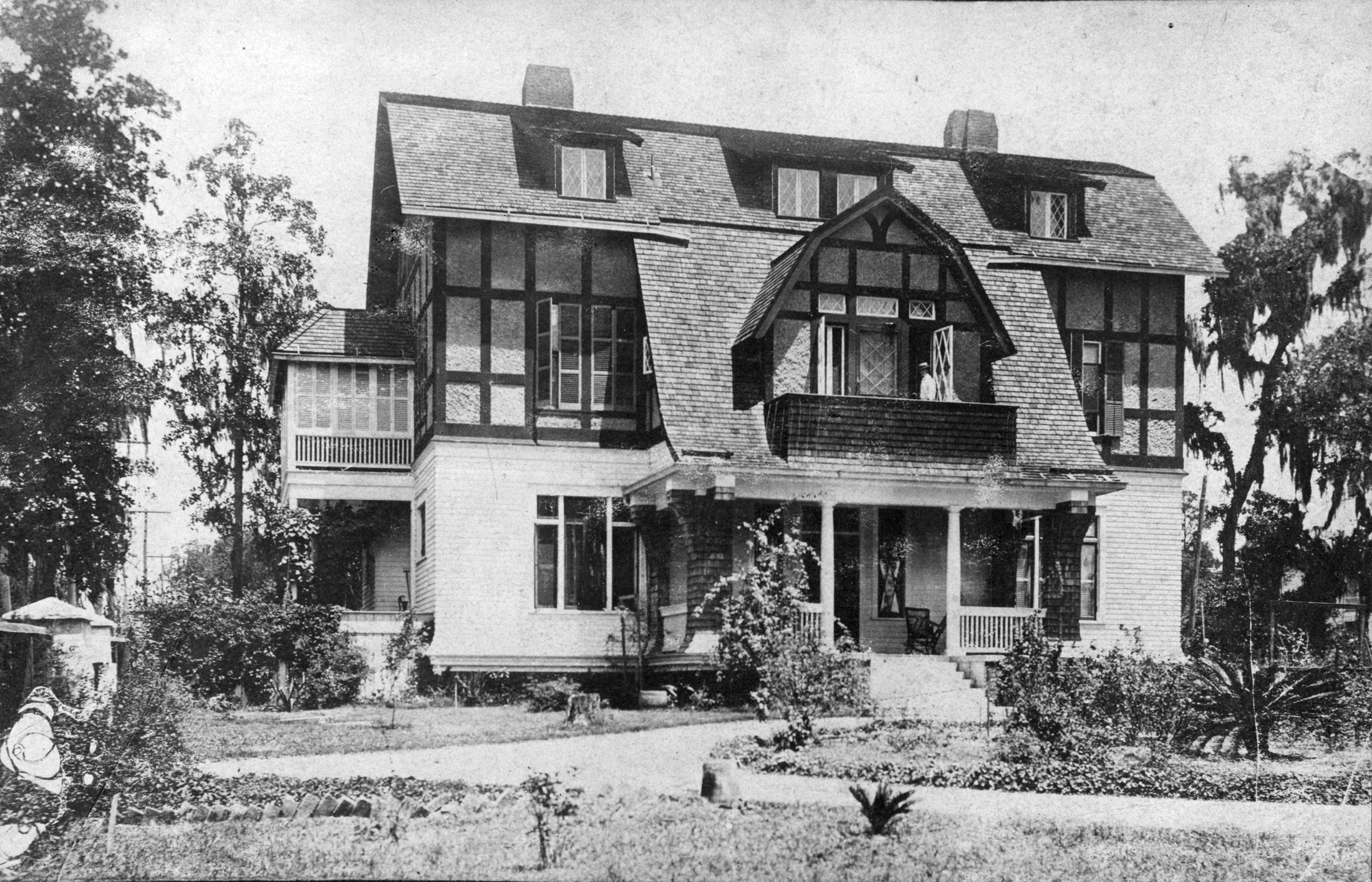
Arthur Gilkes Residence
2160 Oak Street
Date: 1903
Architect: Arthur Gilkes
Arthur Gilkes was one of Jacksonville's most prominent architects when he designed this Tudor-style house for his family in 1903. It originally had a circular fish pond and a sprawling front lawn that stretched all the way to Riverside Avenue. Unfortunately, subsequent owners sold the beautifully landscaped front yard, and an apartment building now obscures the original front entrance. The house still retains its vintage charm, however, with gambrel roofs, half-timbering, and numerous gables, dormers, and balconies. Gilkes' daughter, Lillian, once explained that the family nickname for the house, "Frogmore," was a tongue-in-cheek play on the name of the royal mansion near Windsor Castle in England. When the Gilkes' house was new and there was no bulkhead on the St. Johns River, heavy rains would often cause the river to overflow all the way to Oak Street. This made the land around the house a little swampy, producing a chorus of frogs that often prevented the family from sleeping at night. Lillian Gilkes grew up in the house and went on to become a scholar and author, particularly noted for her biography of Cora Crane.

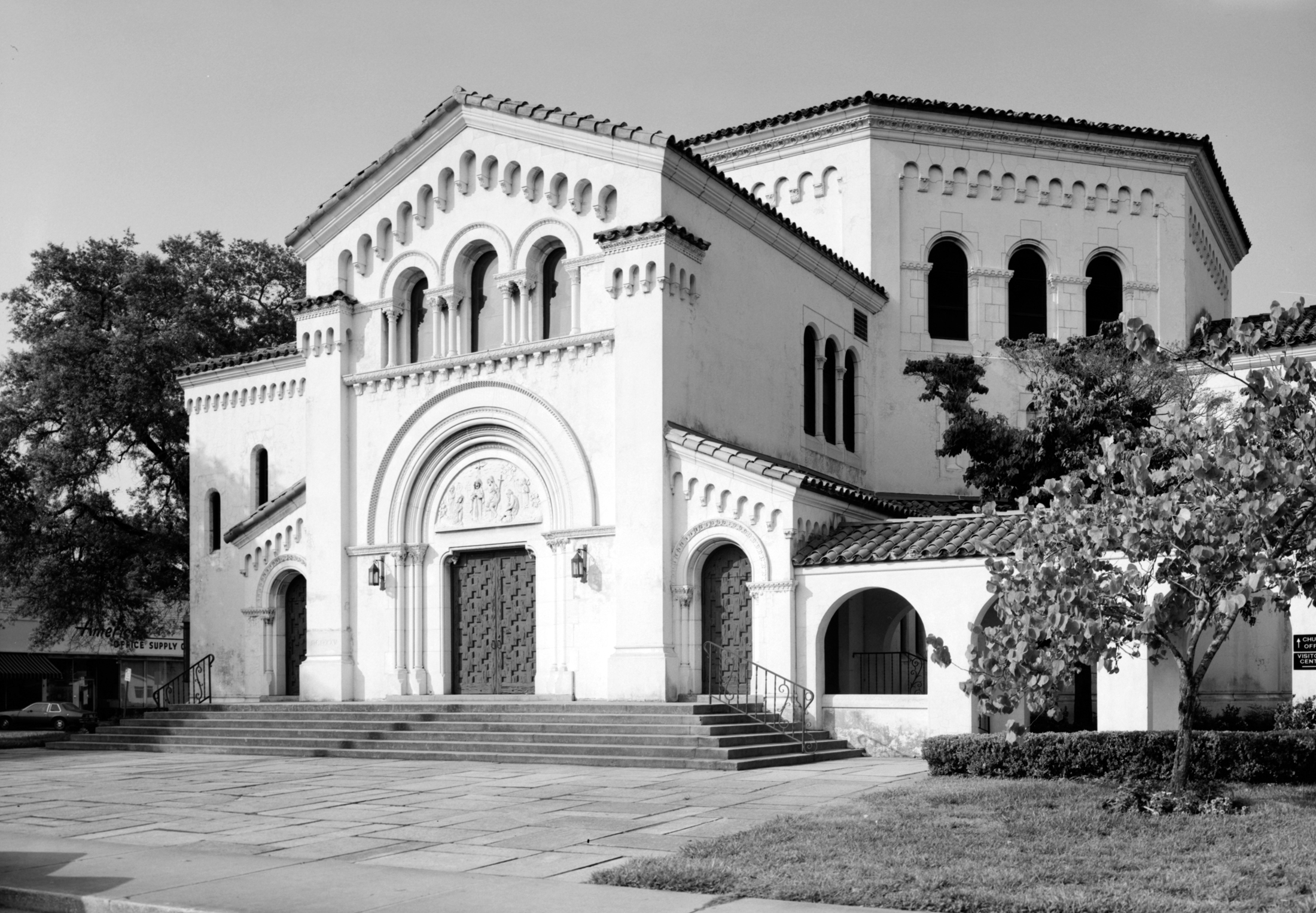
Riverside Baptist Church
2650 Park Street
Date: 1924-1925
Architect: Addison Mizner - Palm Beach
Builder: Ponder-Hammell Company
NATIONAL REGISTER SITE
Addison Mizner was the flamboyant architect of great mansions in Palm Beach and Boca Raton and was the most important individual in popularizing the Mediterranean Revival style in Florida during the boom years of the 1920's. Although Mizner was not known for his religiosity, he was persuaded by Dr. Marshall Taylor and other members of Riverside Baptist to design this church. Perhaps because Mizner had promised his mother that he would design a church in her memory, he agreed to work on Riverside Baptist, the only church he ever designed. Mizner charged no fee for this work. True to the architect's eclectic tastes, the resulting building combines ingredients of Romanesque, Byzantine and Spanish church architecture. Built in the shape of a Greek cross, the church has a large octagonal nave at its center. The interior and exterior are richly adorned with stone carvings, religious ornamentation, and statuary. The red tiles used on the floor were obtained by Mizner from the ruins of a 16th-century Spanish cathedral. Upon completion of the building, some members of the congregation resigned, complaining that the new church was better suited to Episcopal or Catholic taste. Such humorous touches as the sculptured faces of a nun and a monk looking down from the transept walls led some members to feel the architect was mocking them. However, there is evidence Mizner took the design very seriously. Before beginning his design, he sat on a crate every day for a week in the vacant lot, studying the movement of light on the building site. As a result of this careful study, a pleasant bluish light is diffused over the congregation from the blue-tinted windows high above, and the altar is illuminated with a golden glow from the amber windows in the rear gable. The walls of the church were sprayed with milk and rubbed with umber to simulate centuries of age and to create an Old World atmosphere. Riverside Baptist Church displays the vivid genius of Addison Mizner and ranks as one of the most remarkable churches in Florida.

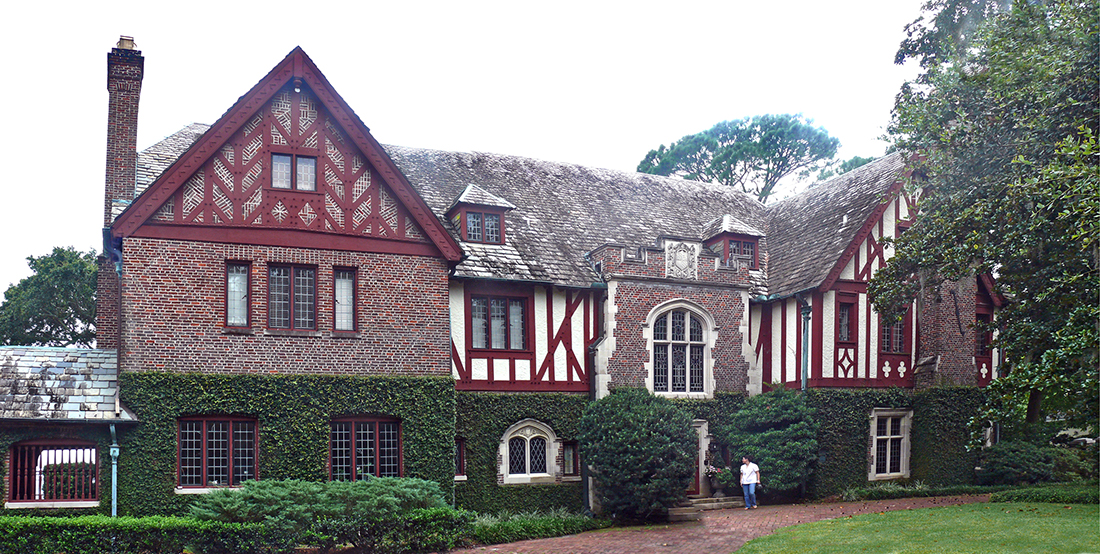
Edward W. Lane Residence
3730 Richmond Street
Date: 1927-28
Architects: Marsh & Saxelbye
Builder: H. S. Baird
This outstanding riverfront mansion is the epitome of the Tudor Revival style in Jacksonville. It was built at a cost of over $130,000 in 1928 for the family of Edward W. Lane, one of the founders of the Atlantic National Bank. Mrs. Lane worked closely with architects Mulford Marsh and Harold Saxelbye to adapt the features she admired most in English architecture. She was so interested in the house that she sat in a lawn chair and supervised the bricklaying. The exterior of the house is a compendium of Tudor Revival architectural details: half-timbering with pegged joints, leaded-glass windows, a slate roof, Tudor-style arches over the doors and some windows, ornamental cast stone, massive chimneys with star-shaped stacks and chimney pots, steep gables with ornate vergeboards, and random-shaped limestone blocks that trim the windows, doors, and corners. The interior is also exceptional. It contains pegged oak floors, elaborate beamed and sculpted plaster ceilings, wainscoting, massive fireplaces, and an octagonal breakfast room with a gold-leaf ceiling. As the biggest house on the largest lot in the entire neighborhood, the Lane residence embodies a style and elegance that is purely Avondale.

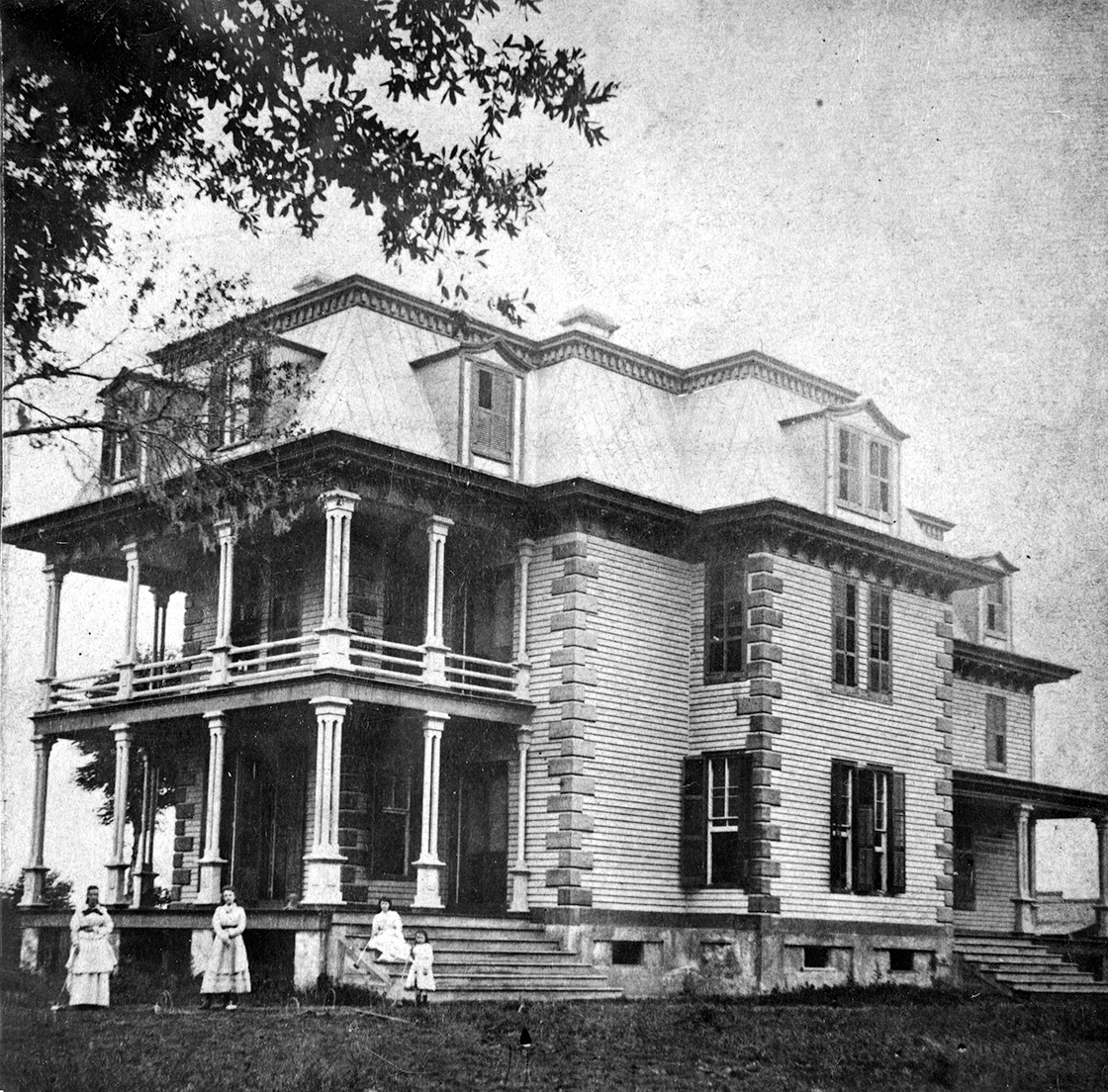
Rochester House
2107 River Boulevard
Date: ca. 1868
First known as the "Rochester House," this three-story Second Empire style building was constructed soon after Miles Price began to sell lots in Brooklyn in 1868. Originally located near the present site of the Florida Publishing Company, the building was a guest hotel. It was described in 1875: "This house . . . is in the suburb of Brooklyn . . . facilities are afforded for boating and fishing. The house will comfortably accommodate from 30 to 40 guests." The property came under the ownership of Isaac H. Jameson for $1,500 in February of 1868. Isaac Jameson opened the Rochester House, also called the River House, which was named in honor of his hometown, Rochester, New York. Guests at the Rochester House came from throughout the northern states. One noted guest was Mary Todd Lincoln, the widow of President Abraham Lincoln, who stayed there Dec. 1874 to March 1875. By 1885 the house was owned by Frederick M. Robinson, a well-known machinery manufacturer. Esgate's Jacksonville: The Metropolis of Florida provides a drawing of the Robinson residence and this narrative: "A large and spacious villa, with airy balconies suggestive of cool and comfort on a warm summer day, faces the river and commands a fine view of that noble waterway and the surrounding country. The grounds are prettily laid out in walks and a fine grove of orange trees lends its dark foliage and golden fruit to the beauty of the scene. A flight of stairs leads down the terraced lawn to the river, which is the common rendezvous of people of leisure who seek pleasure or health in Florida's metropolis." In 1911, the building was moved on a barge up the St. Johns River to its present site. Unfortunately, the two-tiered veranda has been enclosed and some of the dormers have been altered. The building's wooden quoins, bracketed eaves, and mansard roof present an anachronistic contrast with the modern residence next door. This displaced visitor from another century is now used as apartments. It is the only remaining hotel building from Jacksonville's great tourist era in the 1870s and 1880s.

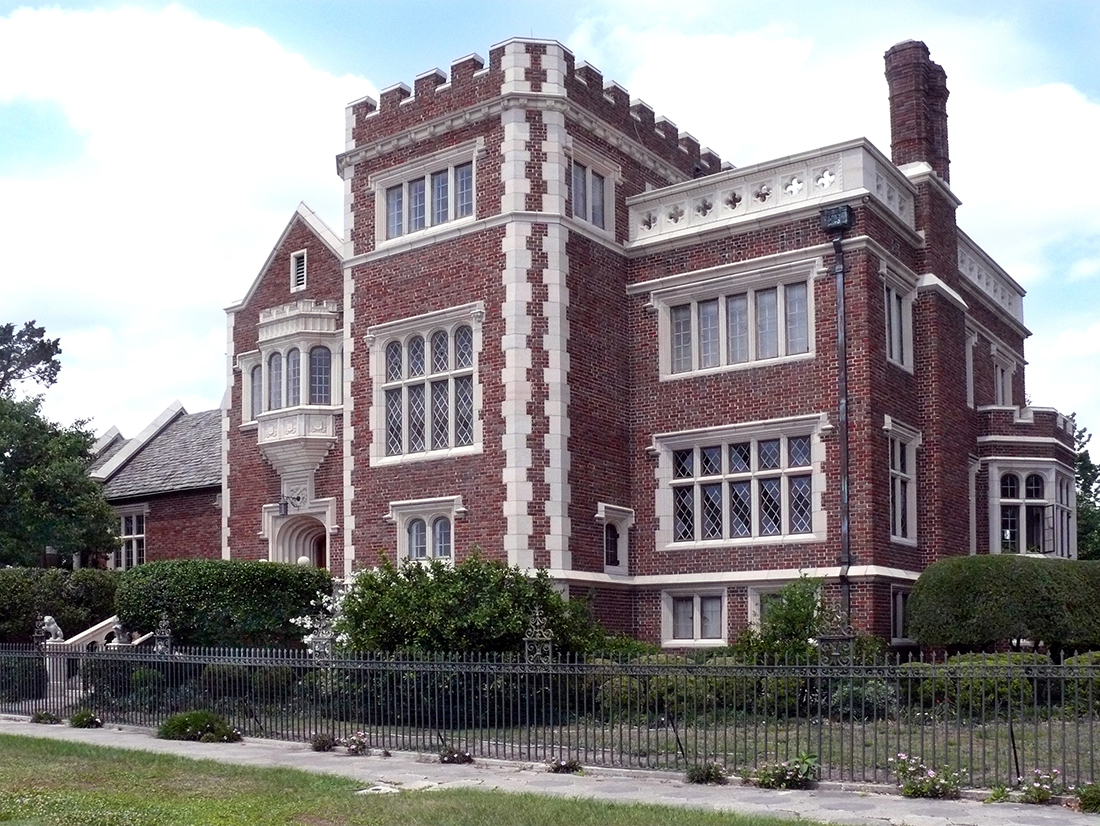
Leon Cheek Residence
2263 River Boulevard
Date: 1928-29
Architect: Roy Benjamin
Builder: Charles J. Davis, Jr.
During the 1920's, revivals of European architectural styles were common. Among the popular English derivatives, the Tudor Revival style with its distinctive half-timbering was most often used for residences. Jacobethan Revival was another style borrowed from the English, and its monumental appearance made it well suited for educational and ecclesiastical buildings (see RA-59 and WJ-6). It was often adapted to residential structures as well, however, and this house is Jacksonville's foremost example of this style. Typical of the Jacobethan Revival, a rich formality is created by the contrast of the dark brick and the white masonry trim that frames every opening of this building. White limestone and cast-stone trim can also be seen in the balustrades, quoins, and various linear bands. This style also shows some of the trappings common with the Tudor Revival style, such as massive polygonal chimneys, a slate roof, leaded glass windows, and Tudor style arches over windows and doors. The most prominent feature of the main facade is the 3 ½-story tower with a crenelated parapet, which contributes to the castle-like quality of this house. Two other noteworthy features are the ornamental iron fence surrounding the residence and the elaborate oriel window above the front entrance. The dramatic scale and riverfront siting make this one of Jacksonville's most significant mansions. It was built in 1928-1929 at a cost of over $100,000 for Leon Cheek, head of the Cheek-Neal Coffee Company, which later became the Maxwell House Coffee Company. The remnants of Cheek's huge private boat dock can still be seen in the river in front of the house.

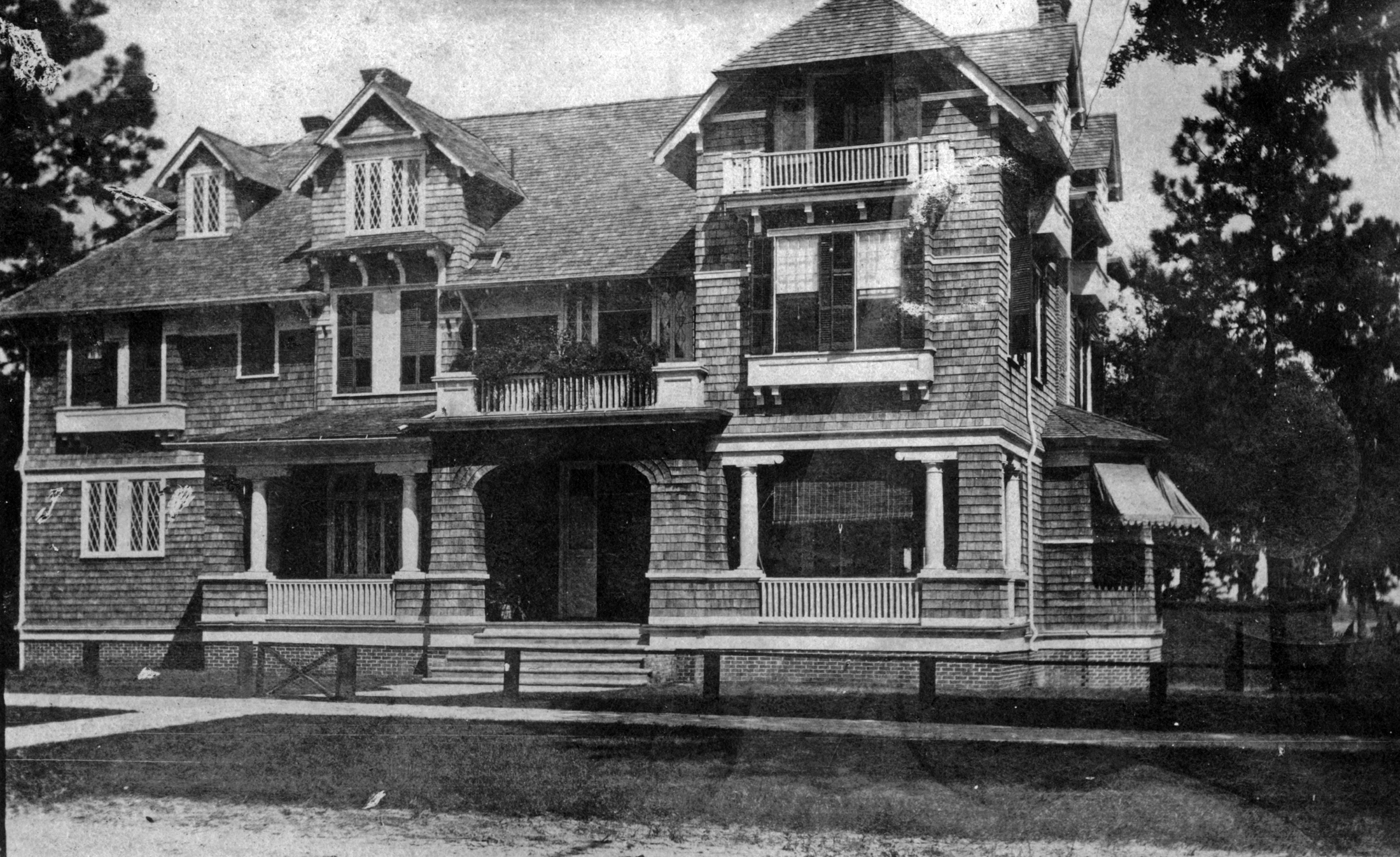
William J. Kelly Residence / Riverdale Inn
1521 Riverside Avenue
Date: ca. 1901-1905
During the early 1900's, this section of Riverside Avenue was known as "The Row" because of its numerous mansions. Between Margaret Street and Edison Avenue, over fifty of these large-scale homes lined Riverside Avenue, making it one of Jacksonville's scenic highlights. Unfortunately, all of these mansions have now been demolished except for two this one and the home at 1541 Riverside Avenue. This house is a striking blend of the Shingle style and the Queen Anne style. Its roof and the walls are almost entirely covered with shingles, including the main porch posts and the arch over the porch entrance. A portion of the veranda lies under the upper stories of a projecting bay, a typical feature of the Shingle style. However, the profusion of gables, balconies, bay windows, latticed window muntins, and scrolled wood trim are traits of the Queen Anne style. The original owner of the house was William J. Kelly, first listed in the City Directory in 1905. He was vice president of Naval Stores Export Company. "Naval stores" was the name given to the turpentine and resin business, which was one of Jacksonville's largest industries at that time. Kelly and the other turpentine magnates were jokingly known as "the Gum Bunch." The original garage behind the house is also noteworthy, with a rare double-jerkinhead cross-gable roof. It is now one of the premiere bed-and-breakfasts in Jacksonville.

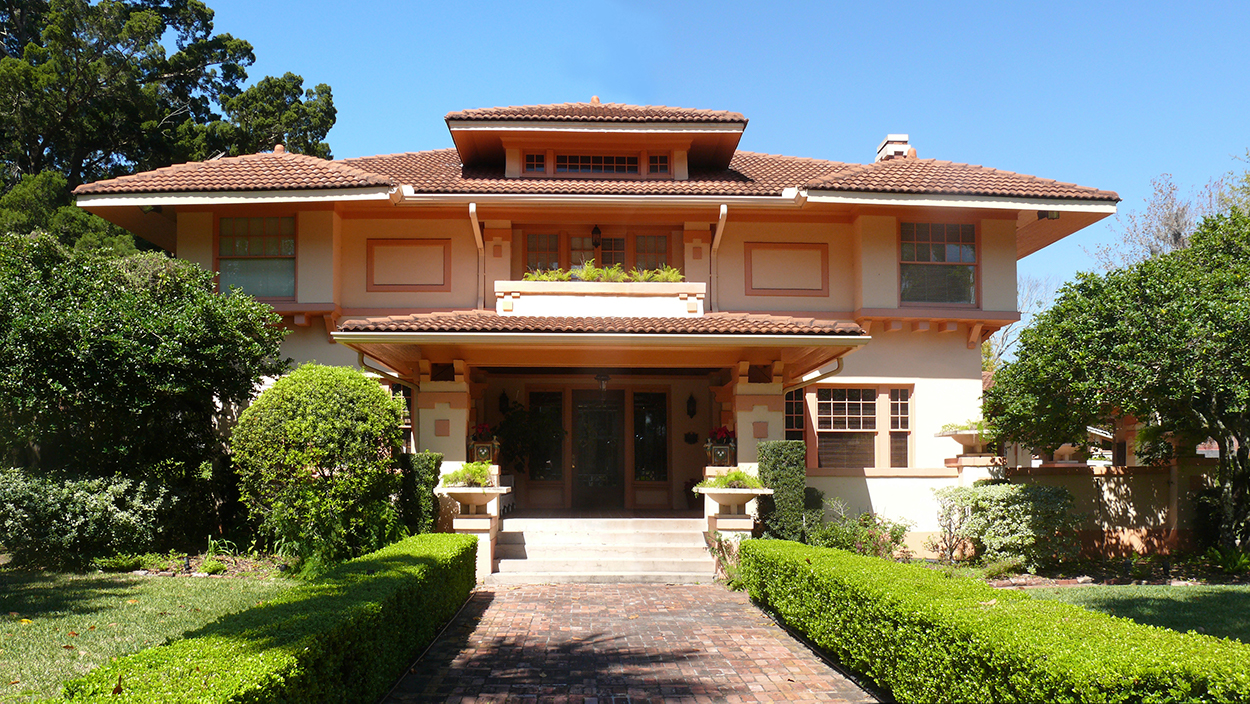
2821 Riverside Avenue
2821 Riverside Avenue
Date: 1913
Builder: N. L. Snelson
Lucius T. Smith, a real estate developer, was the first owner of this house. Although its architect is unknown, the overall design was obviously influenced by Klutho's George W. Clark Residence at 2059 Riverside Avenue (built in 1911 and now demolished). Smith's house originally had a red brick first story, like the garage in the rear, which further emphasized the horizontal flow of the exterior. In 1946 the house was converted to an osteopathic hospital, and a highly unsympathetic addition was added to cover much of the front of the house. Thirty years later it was dramatically restored to become a residence again, but the brick of the lower story could not be salvaged. The identity of the architect of this house has never been officially documented. However, there are clues that it was designed by Klutho's apprentices, Earl Mark and Leeroy Sheftall, who played a major role in designing the George Clark residence. Another interesting hint is that Snelson, the contractor for this house, had an office in the St. James Building next door to architect Klutho at the time this residence was built.

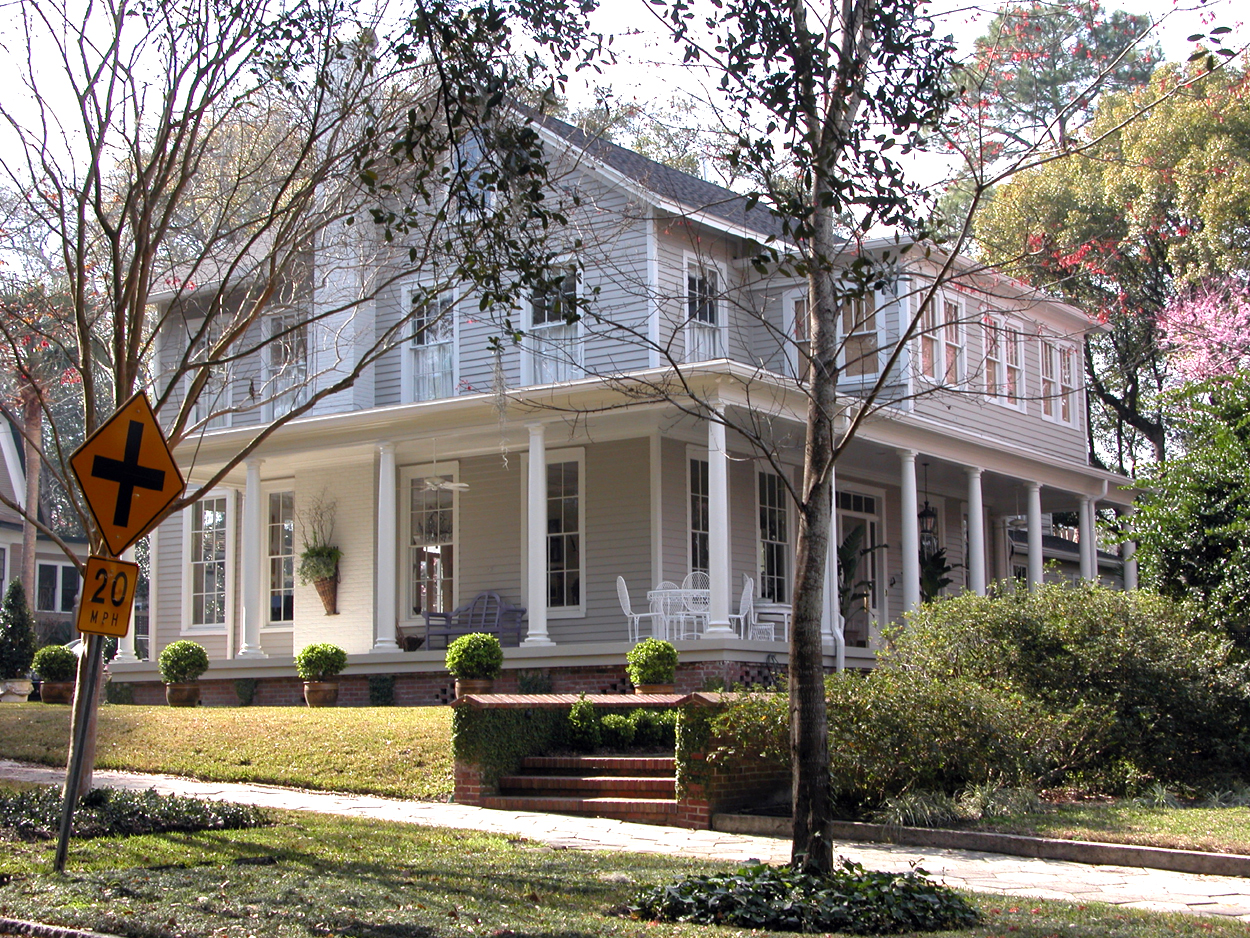
Cheney/Cummer House
2959 Riverside Avenue
Date: ca. 1870
Edward M. Cheney, editor and publisher of the Florida Union and one of the founders of Riverside, lived in this house in 1870. It occupied a site near the present-day Cummer Gallery of Art and was just two doors down from the residence of John Murray Forbes, the neighborhood's other founding father. Today it is one of the area's oldest residences. Lumberman Wellington W. Cummer built a large house adjacent to the Cheney property in 1898, at which time his son Waldo took over this old house. A few years later, Waldo moved the house about two-hundred feet toward the river, where he lived until a new residence was completed on the original site. About 1908 Waldo Cummer barged the old house down the river to Willow Branch Creek, then hauled it to its present location. It was too wide to fit properly on the new site, however, forcing Cummer to turn it sideways and reportedly exclaim in exasperation: "It is so far out in the country, no one will ever notice!" And so it stands today, with its front door facing the neighbor's side yard.

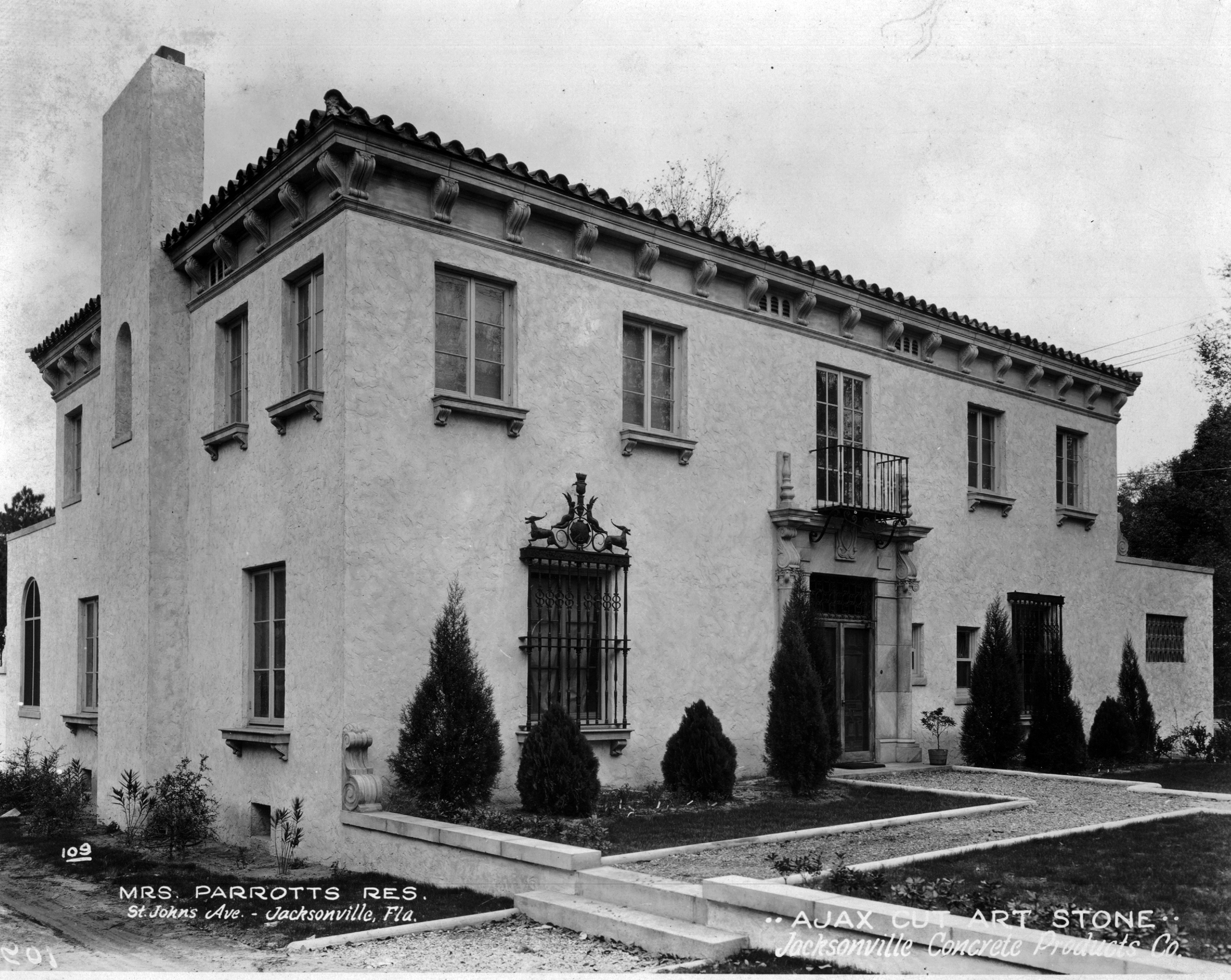
Helen Parrott Residence
3116 St. Johns Avenue
Date: 1923
Architect: Marion Sims Wyeth
Builder: Leadlay Ogden
With a facade suggestive of a Renaissance villa, this is one of Riverside and Avondale's finest Mediterranean Revival style houses. It was designed by Marion Sims Wyeth, an architect from New York who became one of Addison Mizner's chief competitors in Palm Beach. The original owner of the house was Helen L. Parrott. She was the widow of Joseph R. Parrott, the President of Henry Flagler's Florida East Coast Railway. The cost of construction was approximately $34,000. An outstanding feature of the house is its wrought-iron ornamentation, including the entrance gate, balcony, awning support rods, and elaborate window grilles. Cast stone is used extensively in the consoles that decorate the eaves, around the main entrance, and on the bracketed window sills. The weathered stucco exterior and mission-tile roof are further components of the Mediterranean Revival style. From 1958 to 1965, the Unitarian Church occupied the building.

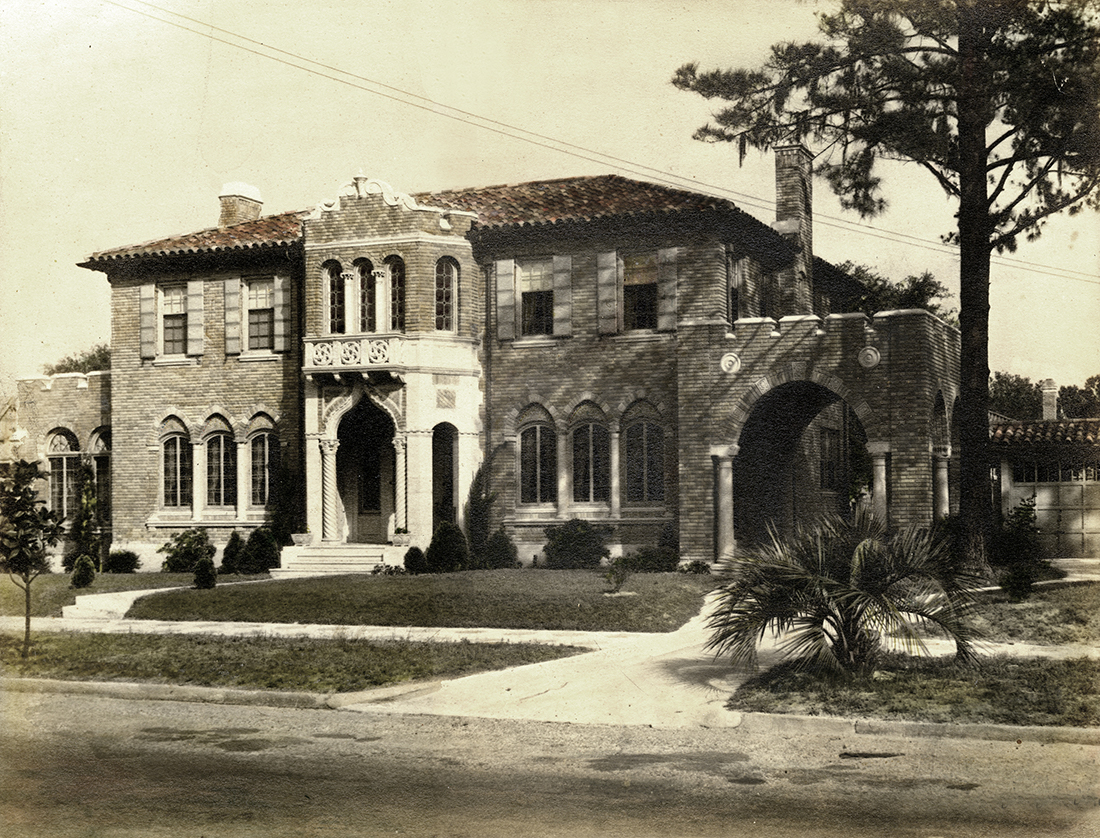
Max Knauer Residence
3404 St. Johns Avenue
Date: 1928-29
Architect: Jefferson D. Powell
Builder: Neil D. Evans
Influenced by the palaces of Venice, Italy, this superb Mediterranean Revival residence is a prominent landmark on St. Johns Avenue. It was designed by architect Jefferson Powell, shortly after he returned from a trip to Venice. The main entrance projects as a two-story pavilion, whose dramatic ogee arch, as well as the star-wheel motif in the balcony, are taken from the Palazzo Contarini-Fasan on Venice's Grand Canal. Various other types of arches highlight the windows, with columns, stylized leaded-glass panels, and several other kinds of brick and cast-stone ornamentation. The porch and porte-cochere are dominated by arches and have crenelated parapets. Even the chimneys have arched windows in them. This mission-tile roof is typical of a Venetian residence. The house was built for Max Knauer, a prominent hardware dealer, at a cost of over $30,000.

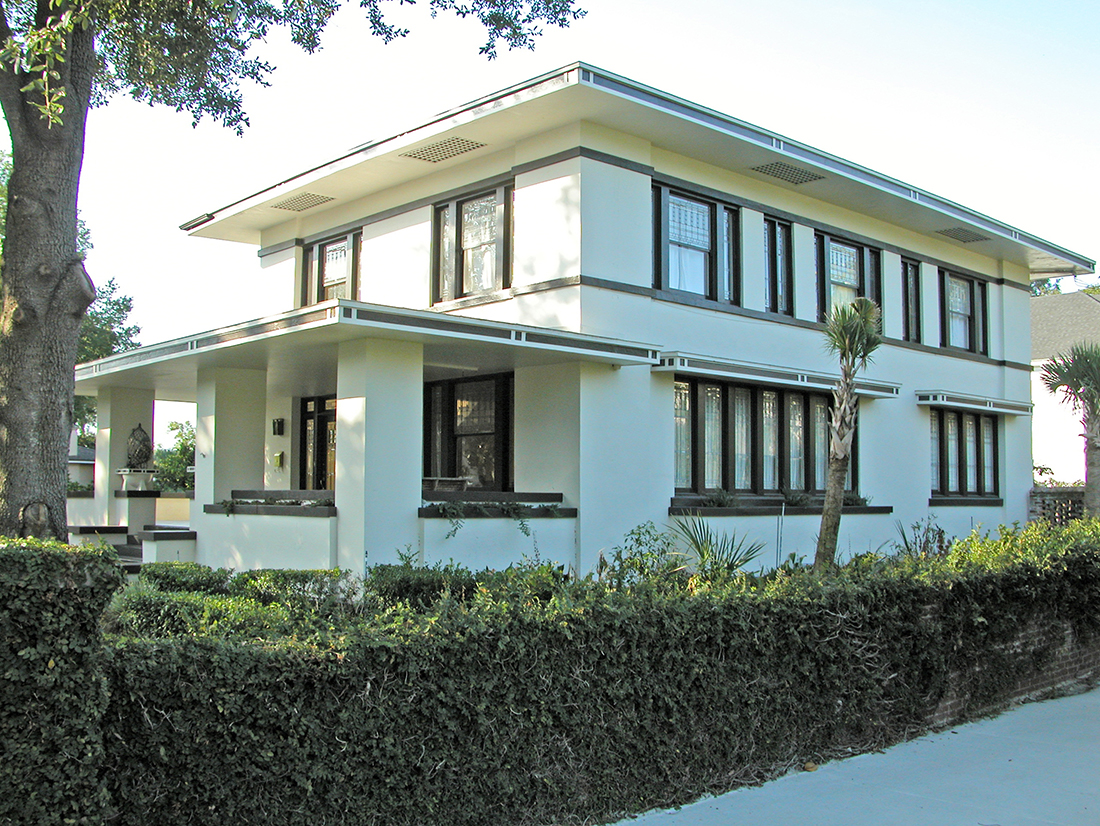
Thurston Residence
1804 Elizabeth Place
Date: ca. 1913
Architect: Wilbur Bacon Camp
This is perhaps the "purest" Prairie Style residence remaining in Jacksonville. Thurston Roberts, vice president of the Monticello Drug Company, commissioned architect W. B. Camp to design the house. The house was considered avant-garde in 1914, and Mrs. Bertha Roberts played a major role in the design. The outstanding leaded and beveled glass casement windows designed by Mrs. Roberts are an integral part of both the exterior and interior of the house. The main roof and the porch roof are cantilevered slabs, emphasizing the horizontality of the structure and allowing the windows to be left open even during rain to allow natural ventilation.

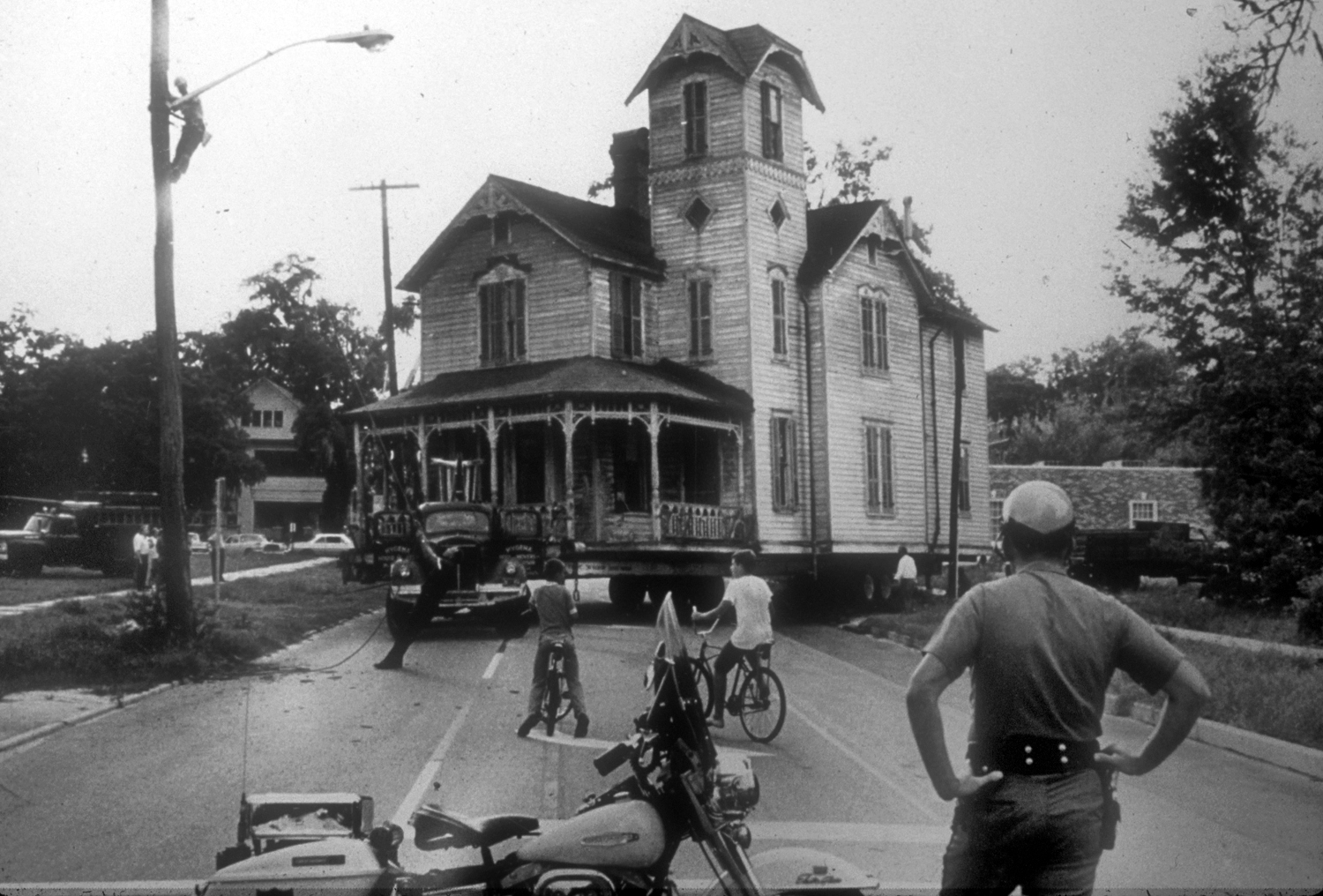
Ernest A. Ricker Residence
757 Riverside Park Place
Date: 1892
With its distinctive tower and profuse wooden gingerbread, this is the finest remaining example of the Queen Anne style in Riverside. It was built in 1892 for the family of Ernest A. Ricker, a dealer in wines, liquors, coffee, and cigars, and also a distributor of Coca-Cola. The house was originally located a block away on Oak Street, where members of the Ricker family lived for three-quarters of a century until Mrs. Ricker died in 1967 at the age of 100. Preservationist Helen Lane acquired the house and moved it to 717 Post Street to avert its demolition. Numerous trappings of the exuberant Victorian architecture are on display here, including asymmetrical massing, scrollsawn and turned-wood ornaments on the porches, a multi-plane roof, and decorative gable ends with incised trimwork. In September, 1999, the house was moved for a third time, to make way for the expansion of Riverside Presbyterian Day School. Ironically, the new site of the Ricker house is back on Oak Street at Riverside Park Place, barely 100 feet from where it was originally located.

